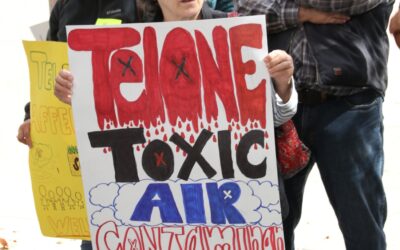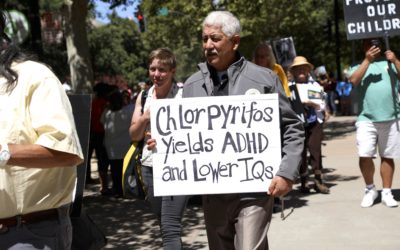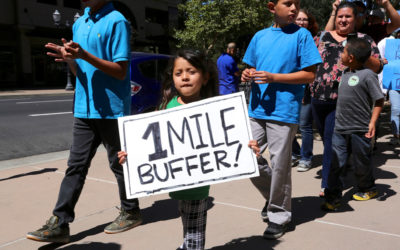Reports
All reports published by CPR may be accessed free of charge online. Downloading reports in PDF format requires Acrobat Reader.
Pesticide Use Violates Civil Rights in California
The Advisory Opinion of the People's Tribunal on Pesticides and Civil Rights finds widespread and systemic violations of the civil rights of farmworking communities in California, whose residents are overwhelmingly Latino and Indigenous.
Are the Lives of Farmworkers Worth 14 Times Less Than Other Californians? The Case of 1,3-D
We know something about the nature and power of the fumigant pesticide 1,3-dichloropropene (1,3-D). Yet, the State body in charge of regulating 1,3-D, the California Department of Pesticide Regulation (DPR), has proposed a policy grounded in toxicity assumptions that...
Grow Organic
In partnership with NRDC and the Swette Center for Sustainable Food Systems at Arizona State University, CPR produced this 2022 report on the climate, health and economic case for expansion of organic agriculture. The full report is here. The executive summary is...
There’s something in the air… and it causes childhood cancer
Recent studies by researchers at UCLA and other California universities have established a link between prenatal residential proximity to 13 pesticides and increased incidence of childhood cancers. Twelve of the 13 are still registered for use in California, and only...
Levels of cancer-causing Telone have spiked this year in Shafter
The highest level ever recorded (50ppb) was measured at DPR's air monitoring station located at Shafter High School in January 2018. Levels were likely even higher in surrounding neighborhoods. When a level of 30ppb was measured in 1990, Telone was banned for five...
What to do in case of pesticide exposure: A community response guide
This guide explains what to do in case of pesticide exposure, whether at home, work, school or in public. The guide includes information on health risk and symptoms, how to report, and who to call for help.
Alternatives to Chlorpyrifos
Chlorpyrifos is a neurotoxic organophosphate (OP) insecticide used in the production of fruits and vegetables throughout the U.S. Because of research showing direct impacts on children’s health, chlorpyrifos was banned for indoor home use in 2001. However, the U.S....
Chlorpyrifos Factsheet
Chlorpyrifos is a potent neurotoxin, widely used in California agriculture. After US EPA Administrator Scott Pruitt in March 2017 defied his own scientists and refused to ban chlorpyrifos, pressure is mounting on California to exercise leadership on the issue....
Kids on the Frontline
Kids on the Frontline reflects a rigorous assessment of dozens of independent studies documenting links between pesticide exposure and children’s health harms. It builds on our extensive 2012 report, A Generation in Jeopardy. The science linking agricultural...
Failing Health: Pesticide Use in California Schools
Failing Health is a survey of pesticide use in many California school districts showing that highly toxic pesticides are used in schools and that parents, policy makers and the public are kept from getting basic information about pesticide use in schools. The report...
“P” is for Poison: Update on Pesticide Use in California Schools
by California Public Interest Research Group Charitable Trust, 2000. 32 pages. "P" is for Poison analyzes pesticide use in the 15 largest school districts in California. The report found that highly toxic pesticides are still being used in California schools. It...
Healthy Schools Pesticide Action Kit
This kit has resources to help you get hazardous pesticides out of your schools. It provides information for parents to take full advantage of the Healthy Schools Act of 2000, ideas on how to organize community interest in least-toxic Integrated Pest Management (IPM)...
Learning Curve: Charting Progress on Pesticide Use and the Healthy Schools Act
by California Public Interest Research Group Charitable Trust, 2002. 40 pages. Over one year after the Healthy Schools Act went into effect, Learning Curve reports on pesticide use and compliance with the Act in California's 15 largest school districts. The report...
Green Schools Within Reach: Moving Beyond the Healthy Schools Act of 2000
In 2000, California enacted a landmark law to protect schoolchildren, the Healthy Schools Act of 2000. The law was among the first in the United States to require notification of pesticide use at schools and to favor safer, greener pest management techniques - known...
Poisoning the Air: Airborne Pesticides in California
Poisoning the Air outlines the problems of airborne pesticides at the agricultural-urban frontier and in urban structural fumigations, discusses health effects of airborne pesticides and reveals how government agencies have failed to implement laws to protect the...
Policy Brief: Better Safe than Sorry: Preventing Pesticide Drift in California
This article calls on California’s Department of Pesticide Regulation (DPR) to take immediate actions to prevent pesticide drift incidents, including phasing-out highly toxic and drift-prone pesticides
Pesticide Protection Zones: Keeping Kids Safe at School
Pesticide Protection Zones: Keeping Kids Safe at School analyzes current requirements for protection zones around schools in California’s 25 largest agricultural-production counties.
Healthy Children & Green Jobs: A Platform for Pesticide Reform
The Californians for Pesticide Reform coalition is releasing Healthy Children & Green Jobs: A Platform for Pesticide Reform, health-protective policy for the incoming Brown Administration.
A Generation in Jeopardy: How pesticides are undermining our children’s health & intelligence
Kids today are sicker than they were a generation ago, and a growing body of scientific evidence points to pesticides as a reason why.
Protecting Their Potential: Ensuring California’s school children are safe from hazardous pesticides
Analysis and policy recommendations based on California Department of Public Health report on pesticide use near schools















